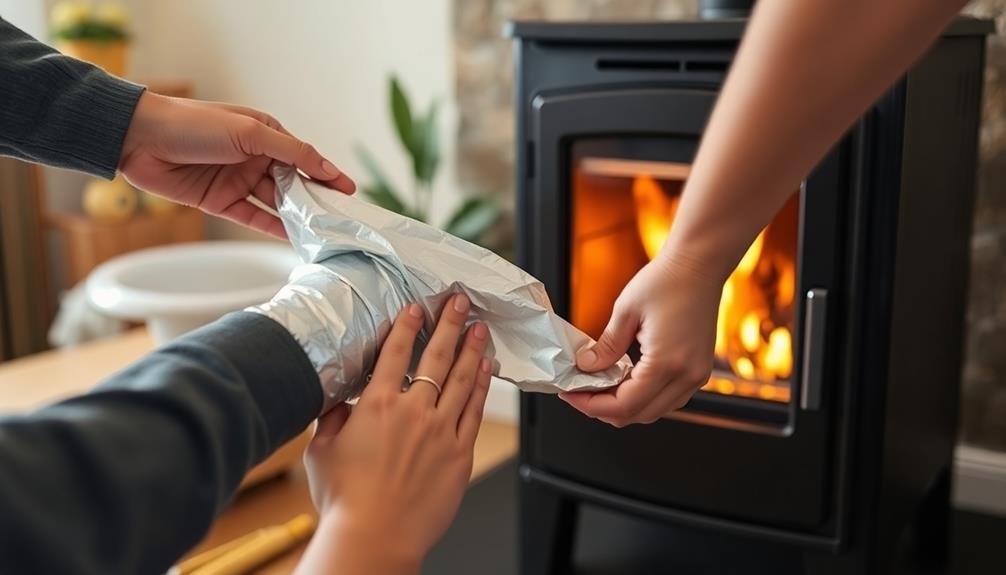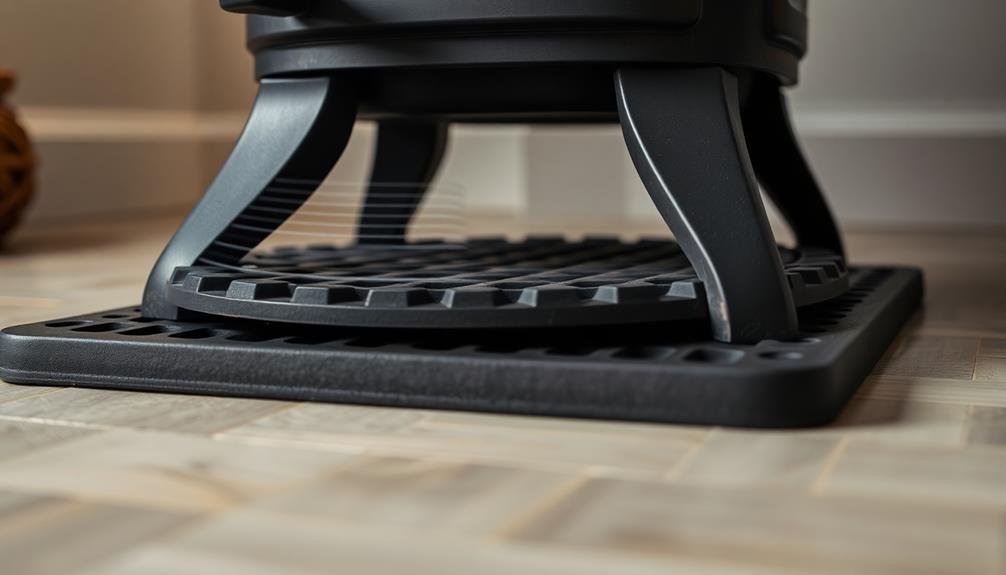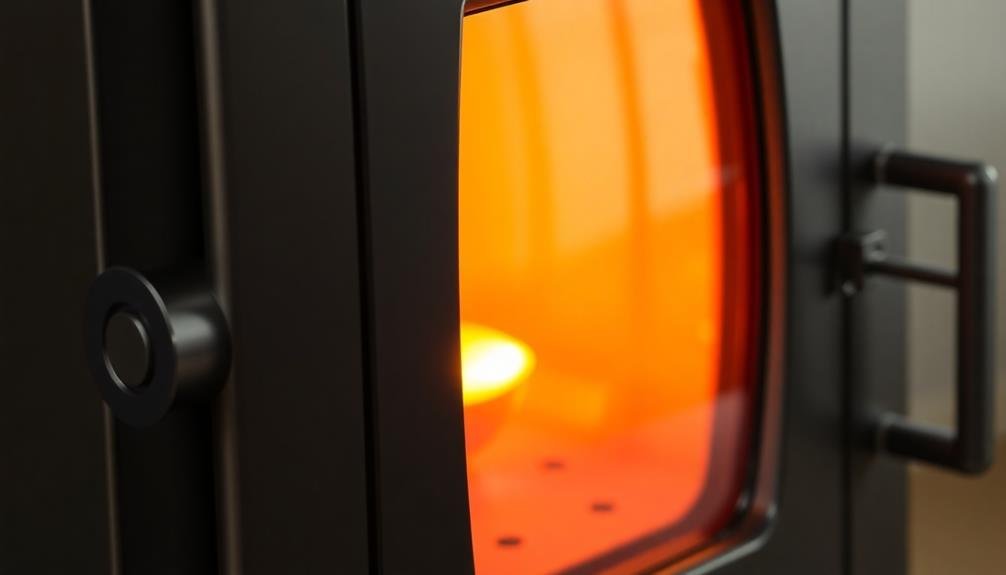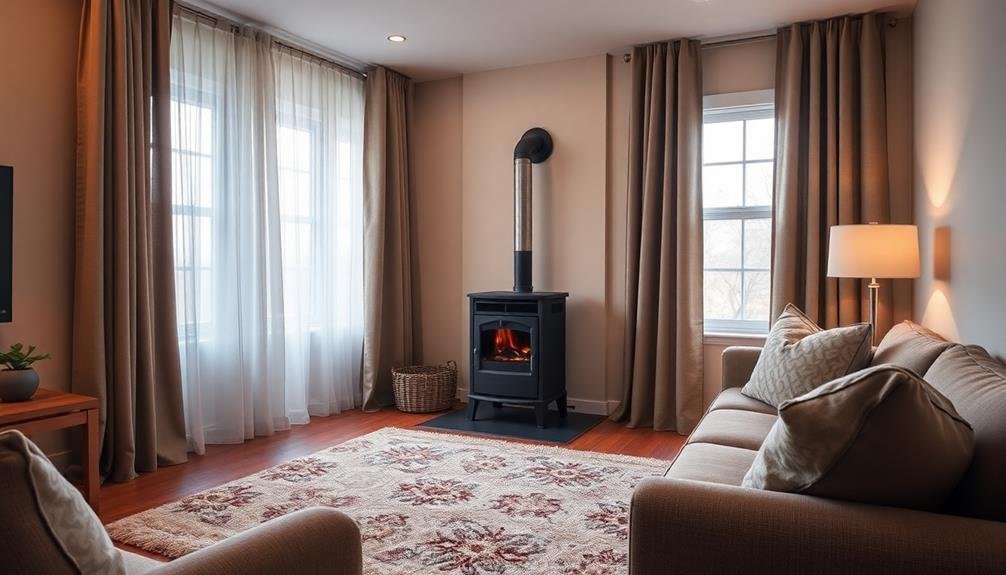To quiet your pellet stove, start by insulating the exhaust pipe to reduce noise from hot gases and vibrations. Next, adjust airflow settings, including blower speeds and pellet feed rates, for peak performance and reduced noise. Install vibration-dampening pads under the stove to minimize rattling and humming sounds. Regular maintenance, such as cleaning and inspecting components weekly and monthly, can prevent noise-causing issues. Finally, consider upgrading to quieter components like whisper-quiet blower fans and efficient auger motors. By implementing these strategies, you'll create a more peaceful heating environment. Discover more ways to enhance your pellet stove's operation and efficiency.
Insulate the Exhaust Pipe

While many pellet stove owners focus on the unit itself, insulating the exhaust pipe can greatly reduce noise. The exhaust pipe is a significant source of sound transmission, as it carries both the hot gases and vibrations from the stove to the outside.
To effectively insulate your exhaust pipe, you'll need to use high-temperature insulation materials designed for this purpose. Start by measuring your pipe's diameter and length to determine how much insulation you'll need. Purchase a fire-resistant insulation wrap or sleeve that can withstand the high temperatures of the exhaust.
Before installation, verify the pipe is clean and free of debris. Carefully wrap the insulation around the pipe, securing it with heat-resistant tape or wire. Pay special attention to joints and bends, as these areas are prone to heat loss and noise transmission.
For additional sound dampening, consider adding a layer of sound-absorbing material over the insulation. This can be a fire-resistant foam or mineral wool. Remember to leave enough clearance around the pipe as specified by your stove's manufacturer.
Adjust Airflow Settings
Optimization of your pellet stove's airflow settings can greatly reduce noise while improving overall performance.
Start by adjusting the combustion blower speed. Lower speeds typically result in quieter operation, but you'll need to find the right balance to maintain efficient burning. Most pellet stoves have a control panel or dial that allows you to fine-tune this setting.
Next, check the convection blower, which distributes heat throughout your space. Like the combustion blower, running it at a lower speed can reduce noise. However, make certain it's still moving enough air to effectively heat your room.
Don't forget to examine the air intake. If it's too restricted, your stove may work harder and noisier to draw in sufficient air. Clean or adjust the air intake as needed to optimize airflow.
Experiment with different pellet feed rates. A slower feed rate can lead to a quieter burn, but ensure it's sufficient to maintain the desired heat output.
Keep an eye on the flame; it should be steady and strong, not weak or flickering.
Install Vibration-Dampening Pads

Vibration-dampening pads can considerably reduce the noise coming from your pellet stove.
These specialized pads are designed to absorb vibrations that cause rattling and humming sounds. By placing them strategically under your stove's feet or base, you'll markedly decrease the transfer of vibrations to the floor and surrounding structures.
To install vibration-dampening pads effectively, follow these steps:
- Clean the area beneath your stove thoroughly to guarantee proper adhesion.
- Measure the dimensions of your stove's feet or base to select the right size pads.
- Place the pads under each corner or support point of the stove.
- Gently lower the stove onto the pads, ensuring it's level and stable.
You'll find various types of vibration-dampening pads on the market, including rubber, silicone, and cork options.
Choose a material that's heat-resistant and durable enough to withstand the weight of your pellet stove. For best results, opt for pads specifically designed for appliances or heavy machinery.
Perform Regular Maintenance
Regular maintenance is key to keeping your pellet stove running quietly and efficiently. You should clean your stove at least once a week during the heating season, removing ash and debris from the burn pot, ash pan, and heat exchanger. Don't forget to clean the glass door and check the gaskets for wear.
Every month, inspect and clean the exhaust system, including the venting pipes and chimney. Vacuum the blower fans and motors to remove dust buildup. Lubricate moving parts as recommended by the manufacturer to reduce friction and noise.
Annually, schedule a professional inspection and cleaning. They'll check for worn components, clean areas you can't reach, and guarantee peak performance.
| Maintenance Task | Frequency | Impact on Noise |
|---|---|---|
| Clean burn pot | Weekly | Significant |
| Vacuum blowers | Monthly | Moderate |
| Lubricate parts | Monthly | High |
| Clean exhaust | Monthly | Moderate |
| Pro inspection | Annually | essential |
Upgrade to Quieter Components

Several key components in your pellet stove can be upgraded to reduce noise greatly. Focus on replacing parts that are known to generate the most noise during operation.
You'll find that investing in quieter components can greatly improve your stove's overall performance and your comfort level.
Here are four essential upgrades to evaluate:
- Blower fan: Replace your old blower with a high-quality, whisper-quiet model designed specifically for pellet stoves. This can dramatically reduce the humming and whirring sounds associated with air circulation.
- Auger motor: Upgrade to a newer, more efficient auger motor that operates more smoothly and quietly when feeding pellets into the burn pot.
- Combustion fan: Install a modern combustion fan with improved bearings and balanced blades to minimize vibrations and reduce overall noise levels.
- Control board: Evaluate upgrading to a newer control board that offers more precise temperature regulation and smoother operation of all stove components.
When selecting replacement parts, look for those specifically marketed as "low-noise" or "quiet operation."
You'll often find that these upgraded components not only reduce noise but also improve your stove's efficiency and performance.
Don't hesitate to consult with a professional if you're unsure about which upgrades will best suit your specific pellet stove model.
Frequently Asked Questions
How Far Should a Pellet Stove Be From Combustible Walls?
You'll need to keep your pellet stove at least 3 inches from combustible walls. However, it's best to follow manufacturer's guidelines, as some models require more clearance. Always prioritize safety when installing your stove.
Can I Use Wood Pellets in a Corn Pellet Stove?
You shouldn't use wood pellets in a corn pellet stove. They're designed differently and have distinct fuel requirements. Doing so could damage your stove or create safety hazards. Stick to the fuel type specified by your stove's manufacturer.
What's the Average Lifespan of a Pellet Stove?
You can expect your pellet stove to last 15-20 years with proper maintenance. However, it's not uncommon for well-cared-for stoves to reach 25 years. Regular cleaning and servicing will greatly extend your stove's lifespan.
Are Pellet Stoves Safe to Use During Power Outages?
You can't safely use most pellet stoves during power outages as they rely on electricity for operation. However, some models have battery backups or can be connected to generators, allowing limited use during blackouts. Always check your stove's manual.
How Often Should I Clean the Ash Pan in My Pellet Stove?
You should clean your pellet stove's ash pan at least once a week during regular use. However, if you're using it heavily, you'll need to empty it more frequently. Always check the manufacturer's recommendations for your specific model.
In Summary
You've now got five powerful strategies to reduce your pellet stove's noise. By insulating the exhaust pipe, fine-tuning airflow settings, using vibration-dampening pads, maintaining your stove regularly, and upgrading to quieter components, you'll create a more peaceful home environment. Remember, a quieter stove isn't just about comfort—it's about efficiency too. Implement these tips, and you'll enjoy a cozier, more serene living space while potentially improving your stove's performance. Don't let noise deter you from the warmth and convenience of your pellet stove.





Leave a Reply